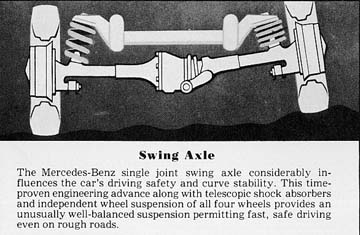
For its independent rear suspension geometry, the earliest 4 cylinder W120 Ponton sedans used a double "swing axle" design. Around 1954-1955, Daimler-Benz first began using the single swing axle design on the 6 cylinder W180 Ponton models, which replaced the previous double swing axles in most of their passenger vehicles.

Figure 1. Single pivot swing axle / rear view / Type W120 180b brochure
The new design included a single pivot point at the rear axle, near the centerline of the car such that the right and left axle shafts could move independently based on the type of road surface that was encountered, thus providing independent shock absorption and improved ride characteristics. At least that was the goal.
Soon after the 6 cylinder Type W180 220a Pontons began incorporating the new single pivot design, the 4 cylinder Type W120 Pontons were also fitted with the single swing axle. The 4 cylinder W121 Pontons only used the single pivot design as they were not introduced until the following year. The basic design along with the rubber axle boots remained the same in most models up until 1972 when the W108 series finished running its course. This includes the W110, W111, W112 "Heckflosse" (1959-1968) series. The same rubber axle boot was used in all Ponton series production cars after the early double swing axles were phased out.
At the time it was introduced, the single swing axle was sufficient for the under powered vehicles they were used on. But as the power and performance of Mercedes-Benz passenger vehicles increased, the design revealed some of its weaknesses. For example, there could be some very undesirable effects under heavy cornering where excessive camber change in the rear wheels could produce unpredictable and difficult break away handling. A vehicle that was noted for this included the Type 300SL "Gullwing" coupé.
Since the same basic design was used for many years in Mercedes-Benz passenger cars (up to, but not including the Type W116 sedan introduced in 1973) the continued development of the single, low-pivot swing axle had largely dealt with those early handling problems. The pivot point was lowered, and later, a horizontal compensating spring was fitted between the rear axle and the right axle shaft to keep the car more stable under various driving conditions.